Lin Zheng
MiniMax-M1: Scaling Test-Time Compute Efficiently with Lightning Attention
Jun 16, 2025Abstract:We introduce MiniMax-M1, the world's first open-weight, large-scale hybrid-attention reasoning model. MiniMax-M1 is powered by a hybrid Mixture-of-Experts (MoE) architecture combined with a lightning attention mechanism. The model is developed based on our previous MiniMax-Text-01 model, which contains a total of 456 billion parameters with 45.9 billion parameters activated per token. The M1 model natively supports a context length of 1 million tokens, 8x the context size of DeepSeek R1. Furthermore, the lightning attention mechanism in MiniMax-M1 enables efficient scaling of test-time compute. These properties make M1 particularly suitable for complex tasks that require processing long inputs and thinking extensively. MiniMax-M1 is trained using large-scale reinforcement learning (RL) on diverse problems including sandbox-based, real-world software engineering environments. In addition to M1's inherent efficiency advantage for RL training, we propose CISPO, a novel RL algorithm to further enhance RL efficiency. CISPO clips importance sampling weights rather than token updates, outperforming other competitive RL variants. Combining hybrid-attention and CISPO enables MiniMax-M1's full RL training on 512 H800 GPUs to complete in only three weeks, with a rental cost of just $534,700. We release two versions of MiniMax-M1 models with 40K and 80K thinking budgets respectively, where the 40K model represents an intermediate phase of the 80K training. Experiments on standard benchmarks show that our models are comparable or superior to strong open-weight models such as the original DeepSeek-R1 and Qwen3-235B, with particular strengths in complex software engineering, tool utilization, and long-context tasks. We publicly release MiniMax-M1 at https://github.com/MiniMax-AI/MiniMax-M1.
MiniMax-01: Scaling Foundation Models with Lightning Attention
Jan 14, 2025Abstract:We introduce MiniMax-01 series, including MiniMax-Text-01 and MiniMax-VL-01, which are comparable to top-tier models while offering superior capabilities in processing longer contexts. The core lies in lightning attention and its efficient scaling. To maximize computational capacity, we integrate it with Mixture of Experts (MoE), creating a model with 32 experts and 456 billion total parameters, of which 45.9 billion are activated for each token. We develop an optimized parallel strategy and highly efficient computation-communication overlap techniques for MoE and lightning attention. This approach enables us to conduct efficient training and inference on models with hundreds of billions of parameters across contexts spanning millions of tokens. The context window of MiniMax-Text-01 can reach up to 1 million tokens during training and extrapolate to 4 million tokens during inference at an affordable cost. Our vision-language model, MiniMax-VL-01 is built through continued training with 512 billion vision-language tokens. Experiments on both standard and in-house benchmarks show that our models match the performance of state-of-the-art models like GPT-4o and Claude-3.5-Sonnet while offering 20-32 times longer context window. We publicly release MiniMax-01 at https://github.com/MiniMax-AI.
Scaling Diffusion Language Models via Adaptation from Autoregressive Models
Oct 23, 2024
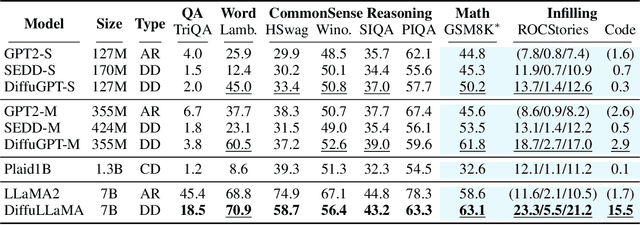
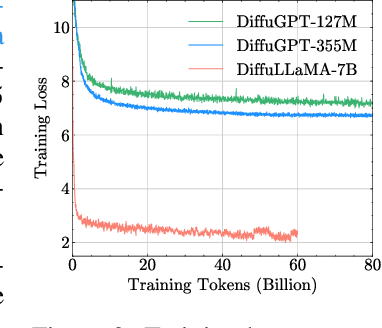
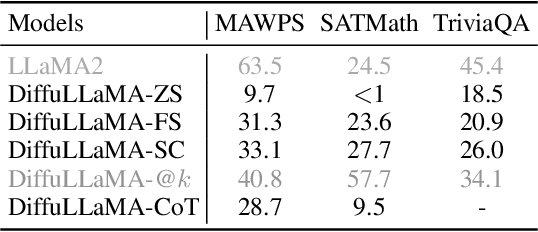
Abstract:Diffusion Language Models (DLMs) have emerged as a promising new paradigm for text generative modeling, potentially addressing limitations of autoregressive (AR) models. However, current DLMs have been studied at a smaller scale compared to their AR counterparts and lack fair comparison on language modeling benchmarks. Additionally, training diffusion models from scratch at scale remains challenging. Given the prevalence of open-source AR language models, we propose adapting these models to build text diffusion models. We demonstrate connections between AR and diffusion modeling objectives and introduce a simple continual pre-training approach for training diffusion models. Through systematic evaluation on language modeling, reasoning, and commonsense benchmarks, we show that we can convert AR models ranging from 127M to 7B parameters (GPT2 and LLaMA) into diffusion models DiffuGPT and DiffuLLaMA, using less than 200B tokens for training. Our experimental results reveal that these models outperform earlier DLMs and are competitive with their AR counterparts. We release a suite of DLMs (with 127M, 355M, and 7B parameters) capable of generating fluent text, performing in-context learning, filling in the middle without prompt re-ordering, and following instructions \url{https://github.com/HKUNLP/DiffuLLaMA}.
Beyond Autoregression: Discrete Diffusion for Complex Reasoning and Planning
Oct 18, 2024



Abstract:Autoregressive language models, despite their impressive capabilities, struggle with complex reasoning and long-term planning tasks. We introduce discrete diffusion models as a novel solution to these challenges. Through the lens of subgoal imbalance, we demonstrate how diffusion models effectively learn difficult subgoals that elude autoregressive approaches. We propose Multi-granularity Diffusion Modeling (MDM), which prioritizes subgoals based on difficulty during learning. On complex tasks like Countdown, Sudoku, and Boolean Satisfiability Problems, MDM significantly outperforms autoregressive models without using search techniques. For instance, MDM achieves 91.5\% and 100\% accuracy on Countdown and Sudoku, respectively, compared to 45.8\% and 20.7\% for autoregressive models. Our work highlights the potential of diffusion-based approaches in advancing AI capabilities for sophisticated language understanding and problem-solving tasks.
SubgoalXL: Subgoal-based Expert Learning for Theorem Proving
Aug 20, 2024



Abstract:Formal theorem proving, a field at the intersection of mathematics and computer science, has seen renewed interest with advancements in large language models (LLMs). This paper introduces SubgoalXL, a novel approach that synergizes subgoal-based proofs with expert learning to enhance LLMs' capabilities in formal theorem proving within the Isabelle environment. SubgoalXL addresses two critical challenges: the scarcity of specialized mathematics and theorem-proving data, and the need for improved multi-step reasoning abilities in LLMs. By optimizing data efficiency and employing subgoal-level supervision, SubgoalXL extracts richer information from limited human-generated proofs. The framework integrates subgoal-oriented proof strategies with an expert learning system, iteratively refining formal statement, proof, and subgoal generators. Leveraging the Isabelle environment's advantages in subgoal-based proofs, SubgoalXL achieves a new state-of-the-art performance of 56.1\% in Isabelle on the standard miniF2F dataset, marking an absolute improvement of 4.9\%. Notably, SubgoalXL successfully solves 41 AMC12, 9 AIME, and 3 IMO problems from miniF2F. These results underscore the effectiveness of maximizing limited data utility and employing targeted guidance for complex reasoning in formal theorem proving, contributing to the ongoing advancement of AI reasoning capabilities. The implementation is available at \url{https://github.com/zhaoxlpku/SubgoalXL}.
Diffusion of Thoughts: Chain-of-Thought Reasoning in Diffusion Language Models
Feb 12, 2024
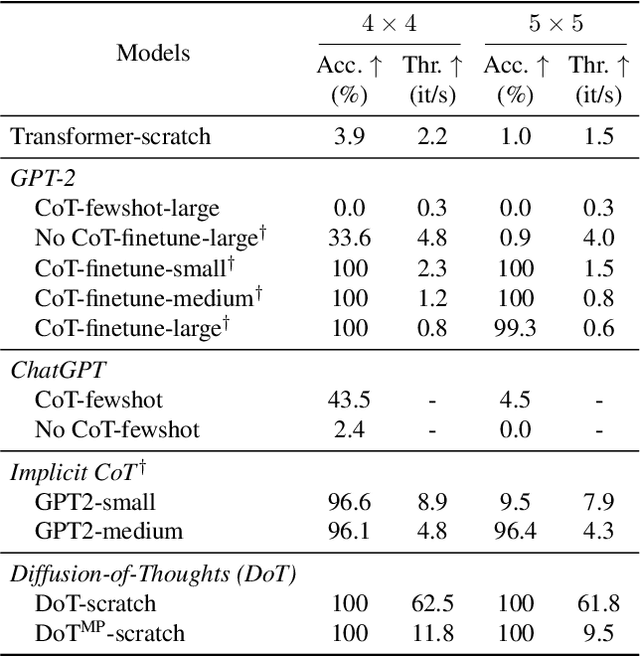

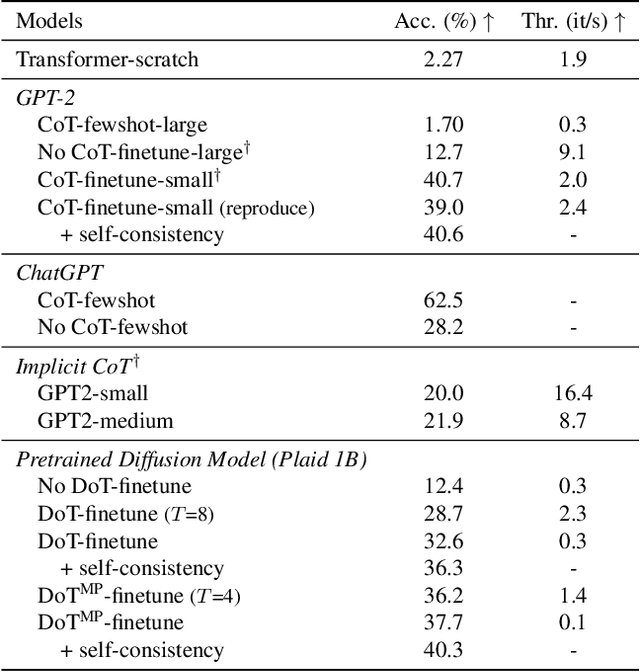
Abstract:Diffusion models have gained attention in text processing, offering many potential advantages over traditional autoregressive models. This work explores the integration of diffusion models and Chain-of-Thought (CoT), a well-established technique to improve the reasoning ability in autoregressive language models. We propose Diffusion-of-Thought (DoT), allowing reasoning steps to diffuse over time through the diffusion process. In contrast to traditional autoregressive language models that make decisions in a left-to-right, token-by-token manner, DoT offers more flexibility in the trade-off between computation and reasoning performance. Our experimental results demonstrate the effectiveness of DoT in multi-digit multiplication and grade school math problems. Additionally, DoT showcases promising self-correction abilities and benefits from existing reasoning-enhancing techniques like self-consistency decoding. Our findings contribute to the understanding and development of reasoning capabilities in diffusion language models.
Linear Attention via Orthogonal Memory
Dec 18, 2023Abstract:Efficient attentions have greatly improved the computational efficiency of Transformers. However, most existing linear attention mechanisms suffer from an \emph{efficiency degradation} problem, leading to inefficiencies in causal language modeling and hindering their application in long-range language models. This problem is more pronounced under language modeling with unbounded contexts. In this paper, we propose \textbf{L}inear \textbf{A}ttention \textbf{V}ia \textbf{O}rthogonal memory~(\shortname) to address these limitations, achieving strong performance while maintaining linear complexity. \shortname employs orthogonal decomposition to compress a context into a fixed-size orthogonal memory while effectively minimizing redundancy within the context. Given that orthogonal memory compresses global information, we further dissect the context to amplify fine-grained local information. Additionally, we embed the relative position encoding into \shortname to improve the extrapolation ability. Experimental results show that \shortname greatly improves the efficiency of the causal language model with the best extrapolation performance and outperforms other efficient baselines. Further, we endeavor to employ \shortname for unbounded language modeling and successfully scale the context length to 128K.
Automated interpretation of congenital heart disease from multi-view echocardiograms
Nov 30, 2023



Abstract:Congenital heart disease (CHD) is the most common birth defect and the leading cause of neonate death in China. Clinical diagnosis can be based on the selected 2D key-frames from five views. Limited by the availability of multi-view data, most methods have to rely on the insufficient single view analysis. This study proposes to automatically analyze the multi-view echocardiograms with a practical end-to-end framework. We collect the five-view echocardiograms video records of 1308 subjects (including normal controls, ventricular septal defect (VSD) patients and atrial septal defect (ASD) patients) with both disease labels and standard-view key-frame labels. Depthwise separable convolution-based multi-channel networks are adopted to largely reduce the network parameters. We also approach the imbalanced class problem by augmenting the positive training samples. Our 2D key-frame model can diagnose CHD or negative samples with an accuracy of 95.4\%, and in negative, VSD or ASD classification with an accuracy of 92.3\%. To further alleviate the work of key-frame selection in real-world implementation, we propose an adaptive soft attention scheme to directly explore the raw video data. Four kinds of neural aggregation methods are systematically investigated to fuse the information of an arbitrary number of frames in a video. Moreover, with a view detection module, the system can work without the view records. Our video-based model can diagnose with an accuracy of 93.9\% (binary classification), and 92.1\% (3-class classification) in a collected 2D video testing set, which does not need key-frame selection and view annotation in testing. The detailed ablation study and the interpretability analysis are provided.
* Published in Medical Image Analysis
Self-Infilling Code Generation
Nov 29, 2023Abstract:This work introduces a general code generation framework that incorporates infilling operations into auto-regressive decoding. Our approach capitalizes on the observation that recent code language models with infilling capabilities can perform \emph{self-infilling}: whereas infilling operations aim to fill in the middle based on a predefined prefix and suffix, self-infilling sequentially generates both such surrounding context and the infilled content. We utilize this feature to develop an infilling-augmented decoding process that facilitates non-monotonic generation. This approach allows for postponing the generation of uncertain code snippets until a definitive suffix is established, leading to improved control over the generation sequence. In addition, it facilitates a looping mechanism, which can iteratively update and synchronize each piece of generation in a cyclic manner. Extensive experiments are conducted to demonstrate that our proposed decoding process is effective in enhancing regularity and quality across several code generation benchmarks.
Attentive Multi-Layer Perceptron for Non-autoregressive Generation
Oct 14, 2023Abstract:Autoregressive~(AR) generation almost dominates sequence generation for its efficacy. Recently, non-autoregressive~(NAR) generation gains increasing popularity for its efficiency and growing efficacy. However, its efficiency is still bottlenecked by quadratic complexity in sequence lengths, which is prohibitive for scaling to long sequence generation and few works have been done to mitigate this problem. In this paper, we propose a novel MLP variant, \textbf{A}ttentive \textbf{M}ulti-\textbf{L}ayer \textbf{P}erceptron~(AMLP), to produce a generation model with linear time and space complexity. Different from classic MLP with static and learnable projection matrices, AMLP leverages adaptive projections computed from inputs in an attentive mode. The sample-aware adaptive projections enable communications among tokens in a sequence, and model the measurement between the query and key space. Furthermore, we marry AMLP with popular NAR models, deriving a highly efficient NAR-AMLP architecture with linear time and space complexity. Empirical results show that such marriage architecture surpasses competitive efficient NAR models, by a significant margin on text-to-speech synthesis and machine translation. We also test AMLP's self- and cross-attention ability separately with extensive ablation experiments, and find them comparable or even superior to the other efficient models. The efficiency analysis further shows that AMLP extremely reduces the memory cost against vanilla non-autoregressive models for long sequences.
 Add to Chrome
Add to Chrome Add to Firefox
Add to Firefox Add to Edge
Add to Edge